
Worldcarblog.com
Tested: Lexus NX350h Luxury AWD Is an Old-School Hybrid
As a traditional-style hybrid, this compact luxury SUV is less expensive than a plug-in but also less desirable.
Although hybrids are proliferating in the compact luxury SUV space, the 2022 Lexus NX350h is in a class of its own. Whereas those other compact luxury SUVs, including the range-topping Lexus NX450h+, are plug-ins (or PHEVs), the NX350h is a traditional-style hybrid.
Compared to a PHEV, the NX350h's much smaller, lithium-ion battery pack has only enough energy to power the SUV short distances on electricity alone, whereas its plug-in peers are all capable of traveling more than 20 miles on battery power. The old-school NX350h still delivers impressive fuel economy, though, and its more basic powertrain also keeps costs down, allowing the $42,700 gasoline-electric Lexus to take the title of most affordable hybrid in its segment.
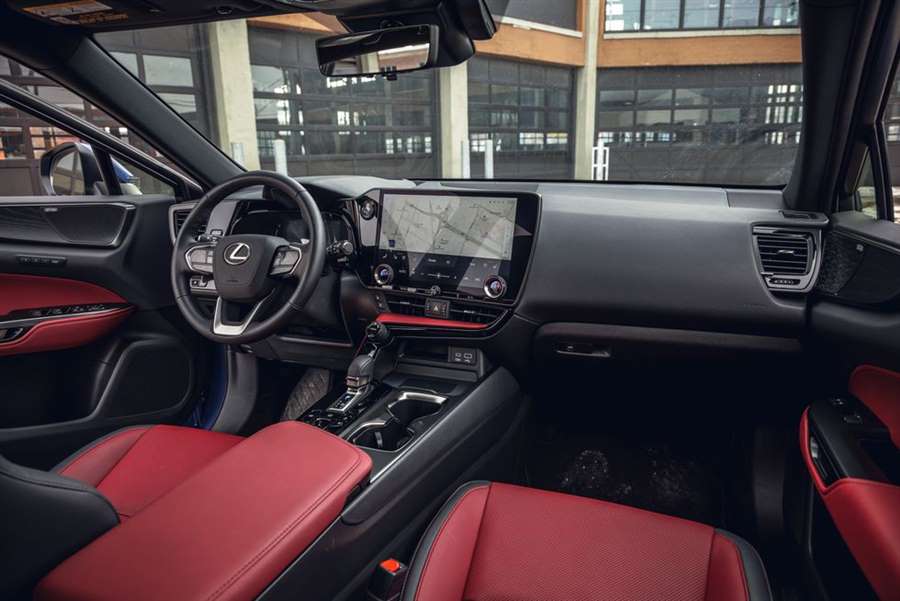
The Price You Pay
That said, going heavy on the options can quickly cut into the cost-effectiveness of the NX350h, with our Nori Green Pearl test vehicle wearing $13,630 in options. The priciest was the $7450 Luxury package, which added heated and ventilated front seats, a power-adjustable steering column, ambient interior lighting, a 10.0-inch head-up display, and a massive 14.0-inch infotainment screen with in-dash navigation in place of the standard 9.8-inch display.
HIGHS: Least-expensive hybrid in its segment, comfortable ride, quality interior.
While both infotainment options feature physical knobs for adjusting the temperature of the dual-zone automatic climate-control system and the audio volume, neither includes a physical control for audio tuning or a dedicated homepage, the lack of which makes navigating through the system's menus an unnerving experience. As Steve Krug writes in his book Don't Make Me Think, a homepage is like "a North Star," providing a comparatively "fixed place" to return to in a digital environment that otherwise requires users to remember where they are in the setup's "conceptual hierarchy [to] retrace [their] steps."
Though it vastly improves upon the maddening touchpad interface of the outgoing model, the latest NX's touchscreen system is not without its flaws. This sentiment also applies to the NX350h's powertrain.
Driving Dynamics
The all-wheel-drive NX350h packs an additional 45 horses compared to its predecessor, extracting a total of 239 horsepower from its 2.5-liter four-cylinder engine and trio of electric motors. (There are two up front—one of which connects to a planetary gearset to mete out the combustion engine's power in a manner that mimics a belt-driven continuously variable automatic transmission—and one mounted at the rear axle.) Factor in a curb weight of 4062 pounds, 151 fewer pounds than the last NX300h we tested, and it's little surprise the 2022 NX hybrid is also a good deal quicker.
Accelerating to 60 mph is a 7.6-second affair, while the run from 50 to 70 mph happens in 5.0 seconds, figures that cut 0.5 and 0.6 second from those of the aforementioned NX300h. Granted, it can't keep up with the 275-hp NX350 or the 302-hp NX450h+. (The turbo four-cylinder NX350 hits the mile-a-minute mark in 6.6 seconds and accelerates from 50 to 70 mph in 4.5; for the NX450h+ F Sport, those times are 5.6 and 3.8 seconds, respectively.) Still, the NX hybrid is less of the slowpoke it once was and now packs acceptable punch for merging onto freeways and passing at highway speeds.
Use all of that performance, however, and the NX350h lets more of the four-cylinder engine's grating grumble enter the cabin. The 75 decibels we recorded under flat-foot acceleration exceeded both that of the NX300h and the Toyota Corolla Hybrid by 1 decibel.
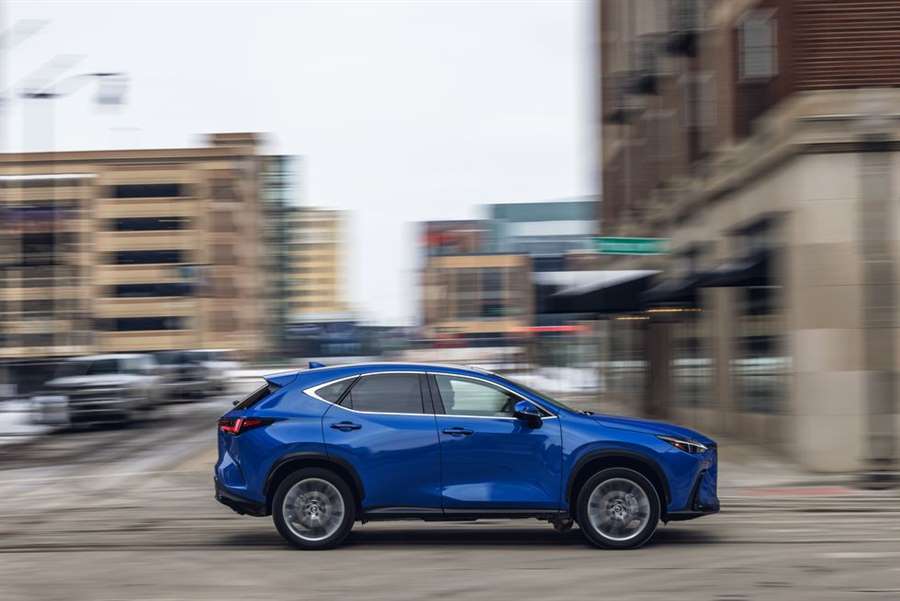
Avoid pinning the accelerator, though, and the interior of the NX350h is appropriately tranquil. Soft springs make for a cushy ride that further contributes to the sense of repose. That softness comes at the expense of body control, as the NX350h wallows through turns and nosedives under braking. Although innocuous enough in day-to-day driving, these motions underscore the fact the NX350h favors a comfortable ride over engaging responses. The nose-heavy Lexus understeers at the limit, and the optional 20-inch Bridgestone Alenza A/S 02 run-flat tires squealed shrilly as the NX350h circled our skidpad at 0.79 g—0.02 g less than its two NX siblings and its NX300h forebear.
Stomp on the left pedal at 70 mph, and the SUV comes to a halt in a class-competitive 180 feet. In non-emergency braking, though, it was difficult to smoothly bring the NX350h to a stop. Blame the pedal's unpredictable action as it switches from regenerative to mechanical braking—particularly in low-speed stops, such as at neighborhood stop signs. Instead of a seamless handoff between its two braking systems, the NX350h suddenly slows at a far greater rate once the mechanical binders take over stopping duties from the electric motors' regenerative function. That awkward modulation is a surprising misstep given that Toyota has been developing and producing hybrids for nearly a quarter of a century.
Dollars and Cents
What the NX350h lacks in grace, it makes up for by way of its low cost of entry. Only devoted plugger-inners whose daily commute is less than the plug-in's range will find a cost savings. Otherwise it will be decades before the additional $14,600 outlay for the 450+ is recouped. On our 75-mph highway fuel-economy test, the NX350h returned 34 mpg, missing the EPA's estimate by 3 mpg.
LOWS: Four-cylinder engine gets shouty at higher revs, not a sporting bone in its unibody, clumsy handoff from regenerative to mechanical braking.
Even the segment's most affordable PHEV, the Lincoln Corsair Grand Touring, is more expensive by $10,305. This does not mean consumers have no reason to choose vehicles such as the Corsair Grand Touring and NX450h+, the latter of which includes a number of dynamic enhancements over the NX350h.
However, it does mean the NX350h, as the least expensive hybrid in its segment, better meets the needs of buyers looking to purchase a hybrid compact luxury SUV as a matter of financial prudence. It may be unexciting and—in some areas—unpolished, but the 2022 Lexus NX350h is arguably a more sensible hybrid option than better-performing PHEVs.
Source: caranddriver.com
Euro 7 rules will be published tomorrow, here's what's changing
The new rules on emissions of harmful gases, whose presentation has already been delayed several times, should see the light of day on Wednesday, according to the announcement of the European Commission. It is a set of rules that will be much stricter than the Euro 6 standard, and implementation is expected after 2025.
New regulations in the form of the Euro 7 standard will limit the emission of harmful pollutants such as PM particles, hydrocarbons and carbon monoxide from petrol and diesel cars and trucks. In this way, the existing Euro 6 regulations, which have been in force since 2014, will be replaced.
Euro 7 will most likely define the pollution parameters for the last generation of internal combustion engines in Europe, because the EU plans to sell only zero-emission vehicles from 2035. Although the European Commission has announced that it will publish the new Euro 7 regulations on Wednesday, October 12, we still cannot say with certainty that this will happen.
Many manufacturers are skeptical about the new regulations, because their fulfillment requires a huge amount of money in the form of investments towards the development of SUS engines, which are going to be retired soon anyway. Certain car brands have already announced full electrification at the end of this decade, so they expressed their dissatisfaction with the timing of the introduction of new, much stricter rules on the emission of harmful gases.
The Tesla truck is coming
Tesla's electric semi truck has been delayed for a long time, and now the company's founder and CEO Elon Musk has confirmed that production has begun.
When Tesla introduced the Semi truck in 2017, production was expected to begin by 2019, but that didn't happen.
Musk then sent an email to employees at the beginning of 2020 in which he stated that the truck is already in limited production and that "it's time to invest everything in order to start mass production." In April of that year, it was announced from Tesla that truck deliveries are being postponed again until 2021.
However, 2021 was not the year of the semi truck either. Shareholders were informed that deliveries were being pushed back to 2022 due to global supply chain issues affecting the tech and auto industries, as well as limited production capacity related to truck batteries at the time.
However, it seems that the wait has finally come to an end as Musk confirmed via Twitter that the first delivery of the Semi truck is expected on December 1st. The trucks will be delivered to Pepsi, which ordered 100 units in December 2017.
Other big companies like Walmart and UPS have also ordered the semi.
In May of this year, the Tesla company began accepting orders from customers with a $20,000 deposit. The semi costs between 150,000 and 180,000 dollars, and the range is up to 800 kilometers.
New Peugeot e-208 2022 review
Efficiency tweaks give the electric Peugeot e-208 supermini a greater range
Verdict
This small update to the e-208 is definitely worthwhile, adding a little extra range with absolutely no drawbacks. However, given Peugeot’s recent announcement that its electric supermini will get a bigger battery (and therefore offer a chunk more range again) and more power, you might want to wait for the new car arriving in 2023. We wouldn’t blame you either way, however.
Peugeot announced a not-insignificant update to its e-208 electric supermini at the end of last year. This boosted the car’s range and tweaked the line-up’s trim structure (along with its pure-petrol 208 sibling), while introducing some style changes to higher-spec models.
But even as we’re testing this new version, Peugeot has revealed still bigger improvements for its e-208.
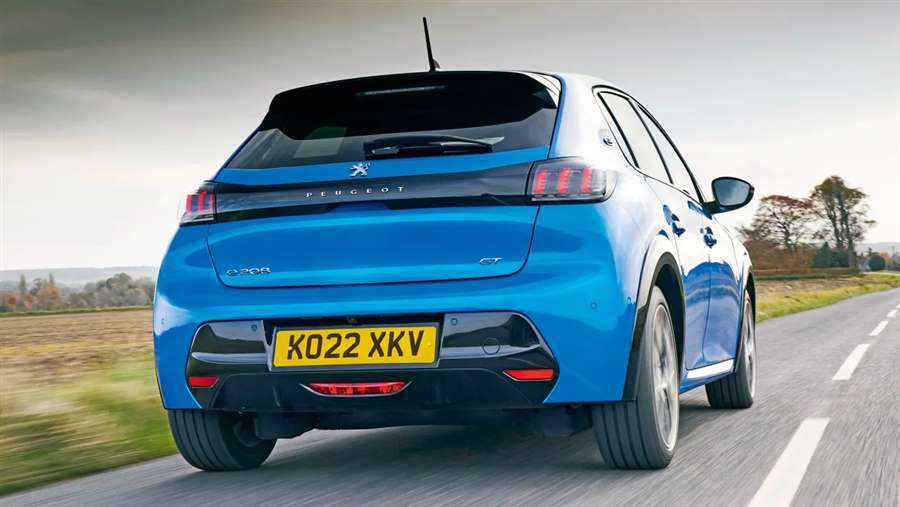
While the car coming in 2023 will get a bigger battery and motor for more range and power, don’t discount this model just yet. Despite no increase to the battery size of the car here, the e-208’s range is now up to 225 miles from 217 miles, a near-four per cent increase, thanks to a revised final drive ratio in the car’s transmission.
Put simply, this reduces the electric motor’s revs when cruising, in turn lowering energy consumption and boosting range. It’s teamed with new ultra-efficient tyres, while a tweak to the heat pump means more efficient use of energy.
On test the e-208 used its energy at a predictable rate; even if it was slightly more than one mile used for every one mile travelled; this relationship still means you can plan journeys accordingly, knowing in advance if you’ll need to stop to charge.
The e-208’s 100kW charging capability hasn’t been updated, but it didn’t need it, so the 50kWh battery takes 30 minutes for a 10-80 per cent charge. The home charging time might be more important to many owners; using a 7kW wallbox, a full charge from empty takes seven and a half hours.
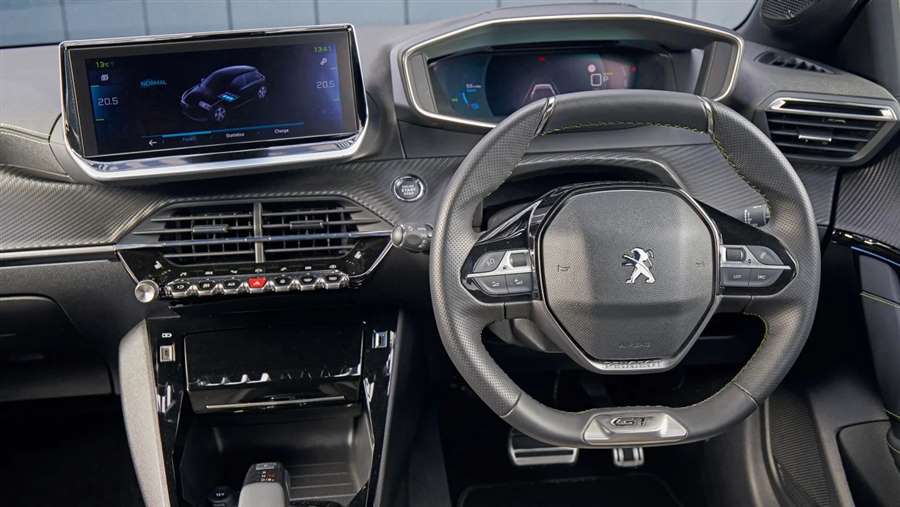
With the motor still producing 134bhp, the Peugeot will cover 0-62mph in 8.1 seconds. Acceleration is still smooth and as swift as you’d ever need from a supermini, with good initial response that tails off towards 50mph. The flexibility the 260Nm of torque and single-speed automatic gearbox give you is great, too.
In town, the e-208 rides patchy roads relatively well. You do get jostled around a little inside, but this is to be expected to some degree because the suspension must absorb inputs and control a body laden with a significant chunk of battery mass. That can also be felt on twisty country roads, where the small steering wheel and quick steering offset some of this slight lethargy.
It still offers as much grip and bite as you’d ever need, and fairly nimble handling. Combined with the instant torque delivery and solid low-down punch EVs tend to bring, this is where the e-208’s fun lies.
There’s also a challenge to be had in maximising regenerative braking and trying to use the left pedal as little as possible. On this front, even in the stronger B mode we’d like a little more motor-derived retardation because it doesn’t allow for one-pedal driving. But it’s an intuitive set-up that’s easy to get to grips with on roads from country routes to motorways. In this latter environment the e-208 is relatively comfortable at speed, although high-speed cruising still isn’t its natural habitat, even with the transmission improvements; you’ll still find the car consuming energy faster than you’d like at a steady 70mph.
Inside, the e-208 is as funky as ever, with a 3D digital dash and a 10-inch central touchscreen. However, the infotainment is also still flawed, with loading times that are longer than rivals’ systems, even if the Peugeot’s does boast plenty of functionality.
Source: autoexpress.co.uk
Customers frustrated: They have to wait up to 30 months for new models to be delivered
While automakers say the delays can be attributed to ongoing chip shortages and overall growth in demand for new vehicles, many buyers believe the Korean automaker is prioritizing overseas markets due to the depreciation of the Korean currency against the US dollar.
Some buyers of Hyundai, Kia and Genesis cars have been told they will have to wait up to two and a half years before the new vehicle they ordered is delivered, the Korea Times reports.
Indeed, the local car trading platform revealed that Korean buyers of the 26 models made by the listed automakers will have to wait up to 30 months for their car, compared to "just" 11 months of waiting a year earlier.
"I have to wait two and a half years to buy a Genesis or any SUV made by Hyundai or Kia? I don't understand," said one customer on a local forum.
"The delay was only seven months last year. Why don't they make them quickly?"
As stated, the compact model Kia K3 and family sedan K5 are waiting three to five months, and up to 8 and a half months for selected versions of the model K5, large sedan K8 and SUV Sorento Hybrid.
Meanwhile, buyers of the Hyundai Avante, Sonata, Grandeur and Santa Fe models will have to wait between six and 20 months before picking up their keys.
A local company official denied claims that overseas customers were a priority.
"Not only Korean consumers, but also overseas consumers have to wait for the vehicle to be delivered," he said.
"The claim that we prioritize foreign consumers at the expense of local ones is simply untrue. Whether it's electric vehicles (EVs) or hybrids, the latest models need the latest chips and parts, which can take time to get. We'll do our best to make it as soon as possible respond to the growing demand for our vehicles."
Shameless copy: Check out the Chinese electric Range Rover that costs 2,700 euros
We are already used to cheap car copies from China, but the latest model offered on Alibaba has "stepped up the game". For only 2,710 euros, you get a not-so-faithful copy of the Range Rover, in a much smaller package with a range of 200 kilometers.
Copies of famous cars coming from China are not rare. A good number of companies from the most populous country in the world have based their products on stealing the designs of well-known brands.
The latest victim of plagiarism is the Range Rover. The Chinese company Sea Biscuit has offered a model on Alibaba that will attract a lot of attention, mostly from the British company's lawyers because it is an obvious design theft. This car has a starting price of €2,710, which is less than most things on the accessories list of a real Range Rover.
For this money, which does not include transportation costs, customers are offered a fully electric microcar with an electric motor that develops 68 hp, while the maximum speed is 50 km/h. The power is transmitted to the rear wheels, and after 10 hours of charging at a classic, domestic outlet, this copy of the Range Rover can travel a maximum of 200 kilometers.

Of course, they did not copy the quality of the interior from the British manufacturer.
As Auto Klub writes, there are cheap plastics everywhere, while the seats are made of fake leather. However, there are two miniature screens and a socket for charging a mobile phone, which add a bit of luxury to the interior.
It should be noted that a discount is also available for larger quantities, so in case the customer orders more than 100 copies, the price drops to only 2,000 euros.
2023 Volkswagen Taos
2023 volkswagen taos suv front parked on a desert track
Subcompact SUVs feed a hunger for space, affordability, and a certain sense of belonging—since almost everyone drives an SUV these days. Among 20 other competitors, the Volkswagen Taos quenches an additional, more recent consumer craving for parsimonious fuel economy. Available in front- or all-wheel drive, every Taos hums along getting exemplary real-world fuel mileage thanks to a stingy, 158-hp 1.5-liter turbocharged four-cylinder engine. The Taos doesn’t offer a hitch to tow with, so we’d suggest moving up to the larger Tiguan SUV for that, but there’s plenty of cargo space inside, even with the rear seats in use, to easily handle grocery duty. It’s a close fight among the best in this class, so the Tiguan’s low starting price and capacious cockpit make it a tempting choice among others such as the Kia Seltos and Chevrolet Trailblazer. Beating its EPA-estimate by 4 mpg, an all-wheel-drive Taos SEL we tested managed an awesome 40 mpg during our 200-mile, 75-mph highway fuel-economy test loop. Copious amounts of interior plastic help keep the Taos’ price down while making the more richly-appointed Mazda CX-30 cabin feel like a miniature luxury condo in comparison with the VW.
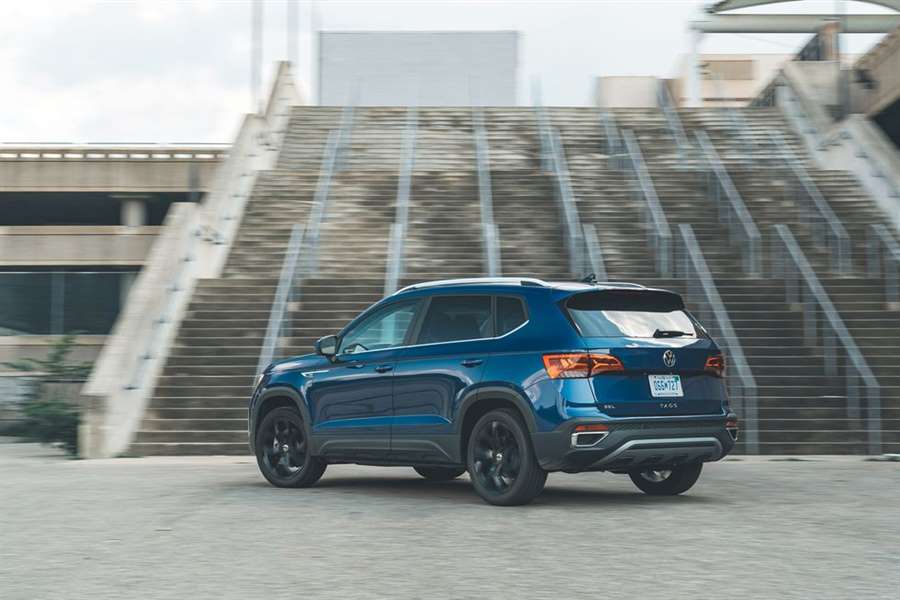
Volkswagen Taos: What's New for 2023?
VW’s smallest crossover doesn’t undergo much change for 2023, but it does receive a few equipment enhancements. Volkswagen adds driver assistance features such as forward collision warning with automatic emergency braking and pedestrian monitoring, blind spot monitor, and rear traffic alert as standard equipment across all trims. The base S gets 18-inch wheels, instead of 17-inchers, on all-wheel-drive models. Lastly, the SEL now get a fancy panoramic sunroof as standard equipment.
We recommend the mid-level SE model because it provides the best value. It comes standard with 18-inch wheels, blind-spot monitoring, heated front seats, remote start, and wireless charging. We'd add all-wheel drive for an extra $1450, largely because it replaces the front-drive model's rear suspension with a more sophisticated independent unit. We'd also opt for the IQ.Drive and SE Convenience packages that add adaptive cruise control, automatic high-beams, a heated steering wheel, lane-keeping assist, and rain-sensing windshield wipers.
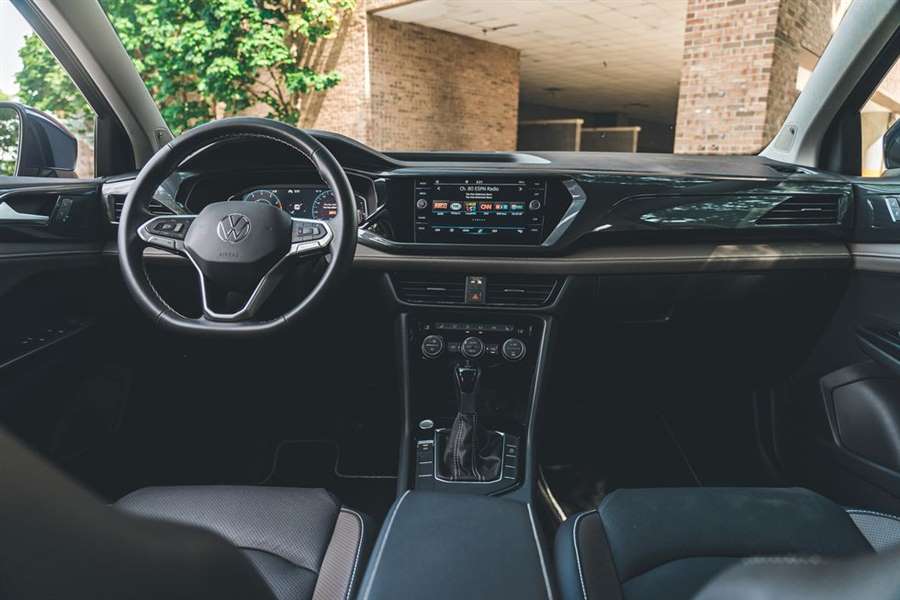
Volkswagen Taos: Engine, Transmission, and Performance
The Taos is powered by VW's new turbocharged 1.5-liter four-cylinder engine. It makes 158 horsepower and 184 pound-feet of torque. Front-drive versions feature an eight-speed automatic transmission, and all-wheel-drive models have a seven-speed dual-clutch automatic. The front-drive and all-wheel-drive Taos also have different rear suspensions, with the former using a torsion-beam setup and the latter using a more sophisticated multilink design. A set of 17-inch wheels are standard, but 18- and 19-inchers are also available. We appreciated the engine's low-speed thrust, the eight-speed automatic's unobtrusive operation, and the suspension's composure on even roads during our time with one.
Volkswagen Taos: Fuel Economy and Real-World MPG
The front-drive Taos is rated at 28 mpg in the city and 36 mpg on the highway, and the all-wheel-drive model is rated at 25 mpg city and 32 highway. We tested a front-drive Taos on our 75-mph highway fuel-economy route, and it earned an impressive 40 mpg, beating its EPA estimate. For more information about the Taos's fuel economy, visit the EPA's website.
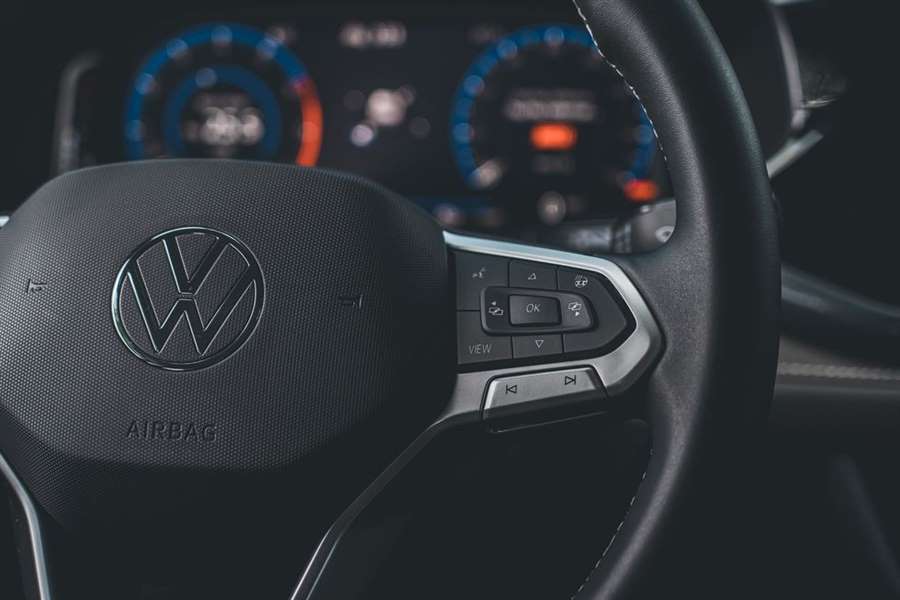
Volkswagen Taos: Interior, Comfort, and Cargo
Inside, there's nothing overtly special about the Taos. The design and materials mimic the modern aesthetic found on other VW models. A fully digital gauge cluster is fitted to every dashboard and the standard two-tone seats are covered in cloth. However, leatherette and leather upholstery are both available, too. There's no shortage of popular options, either. The Taos cabin can be equipped with customizable ambient lighting, an eight-way power driver's seat, dual-zone climate control, a heated steering wheel, heated and ventilated front seats, and a panoramic sunroof. The Taos boasts 37.9 inches of rear-seat legroom, which is only 0.8 inch less than the two-row Tiguan. The Taos also has 28 cubic feet of cargo space behind the rear seatbacks and 66 cubes with them folded flat.
Volkswagen Taos: Infotainment and Connectivity
Every Taos features a slick-looking infotainment system with a subscription-based Wi-Fi hotspot. A 6.5-inch touchscreen is standard, and an 8.0-inch version is optional. The system can also be equipped with built-in navigation, an eight-speaker BeatsAudio stereo, SiriusXM satellite radio, and wireless smartphone charging.
Volkswagen Taos: Safety and Driver-Assistance Features
The smallest VW crossover is available with a variety of driver-assistance technology, too, including forward-collision warning and automated emergency braking. For more information about the Taos's crash-test results, visit the National Highway Traffic Safety Administration (NHTSA) and Insurance Institute for Highway Safety (IIHS) websites. Key safety features include:
- Standard blind-spot monitoring and rear cross-traffic alert
- Standard forward collision warning and automatic emergency braking
- Standard rear traffic alert
Volkswagen Taos: Warranty and Maintenance Coverage
Volkswagen provides an above-average limited warranty and below-average powertrain coverage. However, the company does include complimentary scheduled maintenance that aligns with Toyota.
Limited warranty covers four years or 50,000 miles
Powertrain warranty covers four years or 50,000 miles
Complimentary scheduled maintenance is covered for two years or 20,000 miles
SOurce: caranddriver.com

















